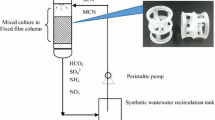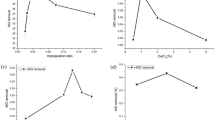Abstract
We isolated ammonia-assimilating microorganisms from the livestock manure treatment systems and evaluated their ammonia-assimilating ability. Many isolates utilized ammonia at high rates when they were purely cultivated in a nitrogen-limited medium to which sterilized lagoon extract had been added. Some isolates that were immobilized in polyvinyl alcohol (PVA) utilized ammonia present in the media containing viable lagoon microorganisms. Staining with 4′,6′-diamidino-2-phenylindole (DAPI) indicated that the immobilized high ammonia-assimilating isolates grew dominantly within the PVA beads. High ammonia-assimilating isolates in the mixed culture containing viable lagoon microorganisms were identified as Pseudomonas spp. and member of Rhizobiaceae species by partial sequencing of the 16S ribosomal DNA.



Similar content being viewed by others
References
Birrer GA, Cromwick AM, Gross RA (1994) Gamma-poly (glutamic acid) formation by Bacillus licheniformis 9945a: physiological and biochemical studies. Int J Biol Macromol 16:265–275
Chen KC, Chen CY, Peng JW, Houng JY (2002) Real-time control of an immobilized-cell reactor for wastewater treatment using ORP. Water Res 36:230–238
Edwards W, Leukes WD, Rose PD, Burton SG (1999) Immobilization of polyphenol oxidase on chitosan-coated polysulphone capillary membranes for improved phenolic effluent bioremediation. Enzyme Microb Technol 25: 769–773
Hansen MN, Sommer SG, Madsen NP (2003) Reduction of ammonia emission by shallow slurry injection: injection efficiency and additional energy demand. J Environ Qual 32:1099–1104
Ho CM, Tseng SK, Chang YJ (2002) Simultaneous nitrification and denitrification using an autotrophic membrane-immobilized biofilm reactor. Lett Appl Microbiol 35:481–485
Hu P, Leighton T, Ishkhanova G, Kustu S (1999) Sensing of nitrogen limitation by Bacillus subtilis: comparison to enteric bacteria. J Bacteriol 181:5042–5050
Lozinsky VI, Plieva FM (1998) Poly(vinyl alcohl) cryogels employed as matrices for cell immobilization. 3. Overview of recent research and developments. Enzyme Microb Technol 23:227–242
Mackie RI, Stroot PG, Varel VH (1998) Biochemical identification and biological origin of key odor components in livestock waste. J Anim Sci 76:1331–1342
McCubbin DR, Apelberg BJ, Roe S, Divita F Jr (2002) Livestock ammonia management and particulate-related health benefits. Environ Sci Technol 36:1141–1146
Merrick M, Edwards RA (1995) Nitrogen control in bacteria. Microbiol Rev 59:604–622
Muyzer G, de Waal EC, Uitterlinden AG (1993) Profiling of complex microbial populations by denaturing gradient gel electrophoresis analysis of polymerase chain reaction-amplified genes coding for 16S rRNA. Appl Environ Microbiol 59:695–700
Nakai Y (2001) Animal waste management and microorganisms. Anim Sci J 72:1–13
Potter M, Oppermann-Sanio FB, Steinbuchel A (2001) Cultivation of bacteria producing polyamino acids with liquid manure as carbon and nitrogen source. Appl Environ Microbiol 67:617–622
Reitzer L (2003) Nitrogen assimilation and global regulation in Escherichia coli. Annu Rev Microbiol 57:155–176
Sasaki H, Maruyama G, Suzuki H, Nonaka J, Sato M, Sasaki T, Ohta M, Nakai Y (2002) Characterization of ammonia-assimilating bacteria in a lagoon for wastewater from a paddock of dairy cattle. Anim Sci J 73:73–76
Sasaki H, Maruyama G, Suzuki H, Nonaka J, Sato M, Sasaki T, Ohta M, Nakai Y (2004) Distribution of ammonia assimilating bacteria in the composting process. Compost Sci Util 12:108–113
Sasaki H, Yano H, Sasaki T, Nakai Y (2005) A survey of ammonia-assimilating microorganisms in cattle manure composting. J Appl Microbiol 99:1356–1363
Szczesna-Antczal M, Antczak T, Bielecki S (2004) Stability of extracellular proteinase productivity by Bacillus subtilis cells immobilized in PVA-cryogel. Enzyme Microb Technol 34:168–176
Tanaka Y, Hayashida S, Hongo M (1976) Treatment of the feces of domestic animals with molds (in Japanese). J Ferment Technol 54:333–339
Zehr JP, Ward BB (2002) Nitrogen cycling in the ocean: new perspectives on processes and paradigms. Appl Environ Microbiol 68:1015–1024
Acknowledgment
This study was supported in part by a grant from the Livestock Technology Association, Japan.
Author information
Authors and Affiliations
Corresponding author
Rights and permissions
About this article
Cite this article
Sasaki, H., Nonaka, J., Sasaki, T. et al. Ammonia removal from livestock wastewater by ammonia-assimilating microorganisms immobilized in polyvinyl alcohol. J Ind Microbiol Biotechnol 34, 105–110 (2007). https://doi.org/10.1007/s10295-006-0172-6
Received:
Accepted:
Published:
Issue Date:
DOI: https://doi.org/10.1007/s10295-006-0172-6




